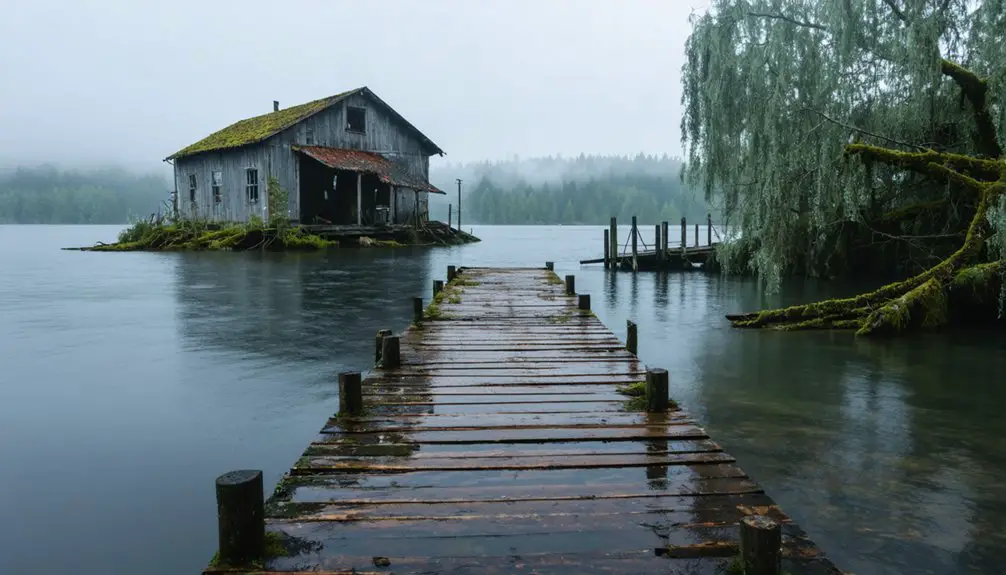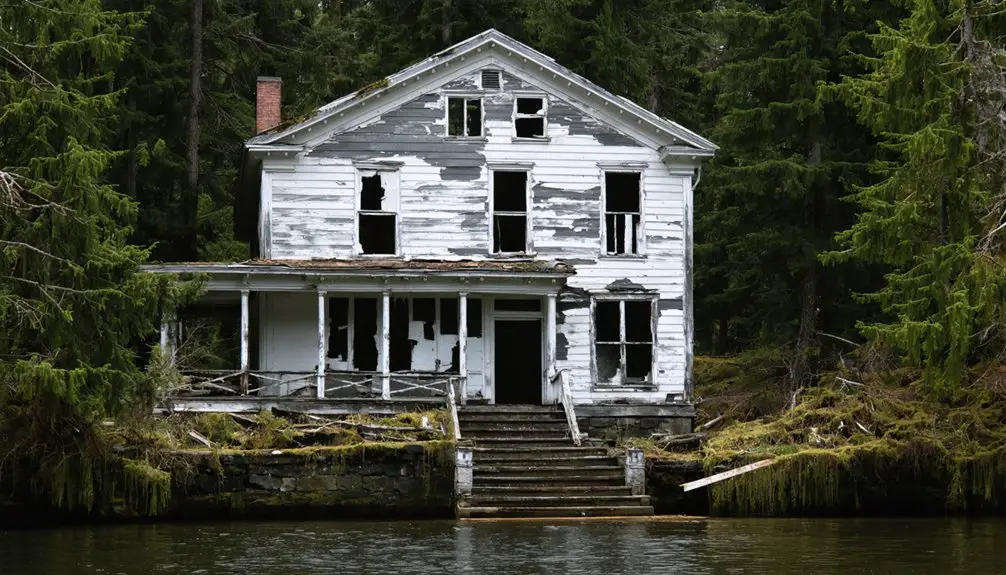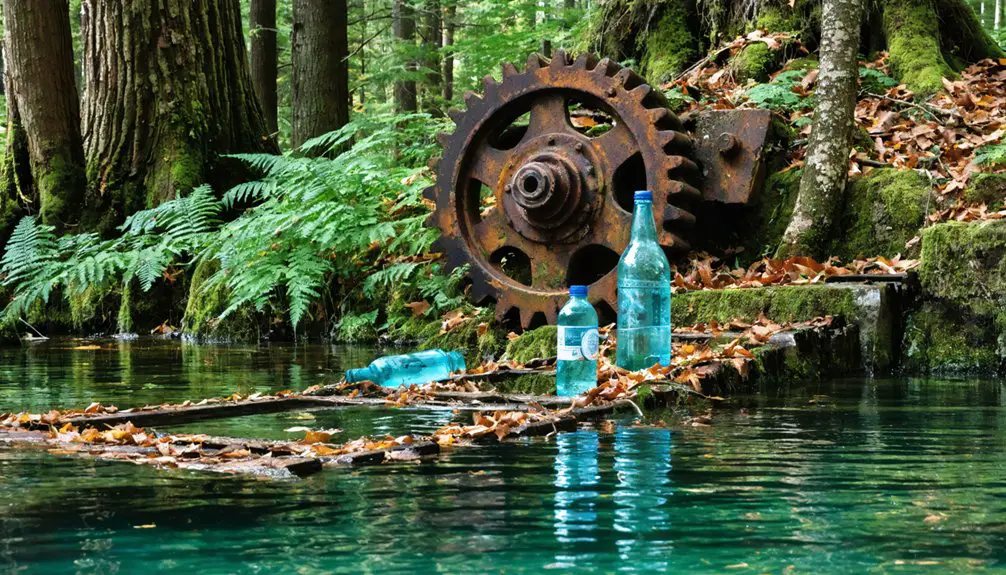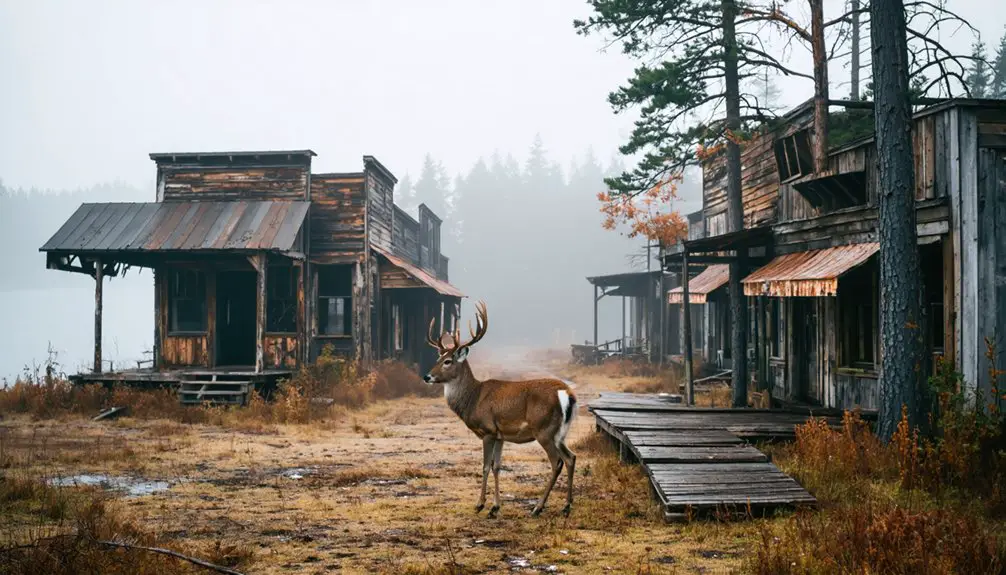You’ll find Clear Lake’s ghost town ruins along Washington’s Skagit River, where tourists once flocked to mineral springs and hiking trails after the Seattle, Lake Shore & Railway arrived in 1890. The area thrived as a resort destination with establishments like the Clear Lake Club Room drawing visitors until the 1920s. By 1960, shifting tourism trends and environmental issues led to the demolition of resort structures. The site’s rich history stretches back thousands of years to its Eastern Pomo origins.
Key Takeaways
- Clear Lake transformed from a bustling resort destination to a ghost town after the Seattle, Lake Shore & Railway’s arrival in 1890.
- Tourism declined by 1920 due to improved air travel options and difficult mountain road conditions.
- Environmental issues, particularly algae blooms, contributed to the area’s economic downturn and resort closures by 1960.
- Unlike mining ghost towns, Clear Lake’s decline occurred gradually due to changing tourism patterns rather than sudden economic collapse.
- The Highland Springs Hotel, a major attraction, operated through various transformations until its Victorian structure burned in 1970.
The Rise and Fall of Clear Lake’s Resort Era

When the Seattle, Lake Shore & Railway arrived in December 1890, Clear Lake transformed into a thriving resort destination that catered to tourists seeking escape from urban life.
You’d find numerous tourist attractions, from natural mineral springs discovered in the 1860s to hiking trails and hunting grounds. Multiple bars and saloons emerged to serve guests, with the Clear Lake Club Room becoming a cornerstone of the bustling business district. The Highland Springs Resort expanded to 2,500 acres, while establishments like Evelyn’s Tavern and the I.O.O.F. Lodge Hall became social hubs for visitors and locals alike. Many guests enjoyed the famous cooking prepared at local establishments, reminiscent of the renowned meals served by Caroline Campbell at Hotel Chelan.
But by 1920, Clear Lake’s golden era began fading. The rise of air travel diverted tourists elsewhere, while challenging mountain roads continued limiting accessibility.
Local indifference led to neglected facilities, and environmental issues like algae blooms damaged the lake’s appeal. This economic decline ultimately led to the demolition or submersion of most resort structures by 1960.
Native American Heritage and Early Settlement
Before Clear Lake became a resort destination, you’d have found Eastern Pomo communities thriving here for thousands of years, with archaeological evidence dating back to 10,000 BC.
The lake basin served as a crucial cultural gathering place where indigenous peoples processed acorns using bedrock mortars, hunted deer and waterfowl, and fished the abundant waters. Like the region’s original inhabitants, they sustained themselves through traditional fishing and hunting practices in the area.
You can trace the extensive trading networks that once connected Clear Lake’s Native communities through artifacts found around the shoreline, particularly near the streams where Eastern Pomo villages were strategically positioned to avoid seasonal flooding.
Similar to how the Coast Salish peoples inhabited the Pacific Northwest for over 10,000 years, these indigenous communities maintained deep connections to their ancestral waters and lands.
Pre-Resort Indigenous Communities
The Clear Lake Basin’s rich indigenous heritage stretches back to 10,000 BC, with nomadic hunter-fisher groups establishing the first human presence in the region.
The Eastern Pomo and Lake Miwok peoples developed sophisticated indigenous subsistence patterns and cultural practices that allowed them to thrive in this abundant landscape. Many Lake Miwok groups practiced the Kuksu religion ceremonies. The Pomo were known for their small band structure, with groups connected through lineage and marriage rather than central political authority.
Their resourceful lifestyle included:
- Building settlements near streams to avoid seasonal flooding
- Hunting deer, waterfowl, and fishing from Clear Lake’s waters
- Gathering acorns and seeds using specialized cone-shaped baskets
- Processing food with innovative tools like bedrock mortars
Before European contact, roughly 3,000 Pomo people called this area home.
Tragically, disease and colonization devastated these communities, reducing the Lake Miwok population to just 20 people by 1920 and the Pomo to about 400 by the late 19th century.
Cultural Gathering Place Significance
For millennia, Clear Lake served as an essential cultural nexus where Eastern Pomo and neighboring indigenous groups gathered to conduct ceremonies, share resources, and strengthen social bonds.
Native peoples called the waters x̌ačuʔ in Lushootseed, reflecting their deep spiritual connection to this sacred place.
Similar to modern place name disambiguation, different tribes had unique names and cultural meanings for this sacred site.
You’ll find evidence of their seasonal gatherings near stream-fed settlements, where they’d process acorns and fish using specialized tools that evolved over generations.
The lake’s spiritual significance shaped cultural identity through potlatch ceremonies and communal longhouse living.
You can trace how these gatherings fostered important knowledge sharing between tribes, while canoe travel connected communities across the region.
Even as Euro-American settlers arrived in the 19th century, Native peoples maintained their connection to Clear Lake, adapting their practices while preserving oral traditions and ceremonial customs tied to this sacred landscape.
Lake Basin Trading Networks
Within Clear Lake’s expansive basin, indigenous trading networks flourished through a complex web of established routes connecting agricultural villages and seasonal gathering places.
Archaeological evidence suggests that rich salmon runs sustained the communities and enabled them to develop extensive trade networks.
The lake basin served as a crucial link in the broader Pacific Northwest trade networks, where tribes exchanged goods across diverse ecological zones. Like the Mandan and Hidatsa villages that anchored Missouri River commerce, Clear Lake’s communities became vital centers of regional exchange.
You’ll find evidence of these dynamic trade networks through:
- Exchange of marine shells, obsidian, and turquoise transported thousands of miles
- Movement of dried salmon and wild plant foods from Columbia Plateau tribes
- Trading of medicinal roots, pigments, and other valuable resources
- Waterway connections that linked Clear Lake’s basin to larger river systems
The lake basin’s strategic position enabled both local tribes and distant trading partners to maintain robust economic relationships, sharing not only goods but also technological knowledge and cultural practices.
Geographic Isolation and Natural Surroundings
Located approximately 3 miles south of Sedro-Woolley in Skagit County, Washington, Clear Lake ghost town sits nestled among dense forests and mountainous terrain characteristic of the Pacific Northwest.
You’ll find natural geographic barriers that once contributed to the town’s isolation – Clear Lake and Mud Lake create water boundaries, while rugged hills and thick timber forests limit access from other directions.
The marine west coast climate, with its year-round rainfall, supports the lush vegetation that surrounds the former settlement.
This environment proved ideal for resource extraction, particularly logging, though it posed challenges for transportation and infrastructure development.
Today, the wilderness has largely reclaimed the area, with the former townsite surrounded by mixed forest landscapes that echo its timber-industry past.
The Highland Springs Hotel Complex

The Highland Springs Hotel Complex began its storied history in 1884 as Smith’s Station, when a Los Angeles company purchased the property and established the three-story Highland Home Hotel under owner Veile.
The property’s historical transformation through various owners shaped its unique character, from a health resort to a thriving vacation destination.
- Under the Hirsch brothers in 1927, it became a vegetarian health retreat attracting celebrities like Einstein and Hemingway.
- The Rosin brothers transformed it into the “Catskills of the West” in 1948, adding tennis courts and entertainment venues.
- A devastating fire in 1970 destroyed the original Victorian structure.
- Today’s Highland Springs Ranch & Inn maintains organic farming practices and preserves historic buildings while offering modern amenities for visitors seeking a natural escape.
Environmental Changes and Dam Construction
While the Highland Springs Hotel Complex flourished as a tourist destination, dramatic changes were unfolding in Clear Lake’s ecosystem during the 1960s. The county’s construction of an earthen dam transformed the natural basin into Highland Springs Reservoir, flooding nearly 2,500 acres of resort sites and forever altering the region’s hydrology.
The dam’s impact reached far beyond the submerged ruins. You’ll find ecological consequences throughout the area, from disrupted fish migration patterns to altered water temperatures and quality.
The retrofitted fish ladders installed in 1992 proved largely ineffective, with steep denil ladders and maintenance issues hampering fish movement.
Today, the reservoir’s stagnant waters have changed nutrient cycles, potentially triggering algal blooms, while the mountainous terrain limits access for environmental monitoring. The dam improved water supply but at a significant cost to local biodiversity.
Archaeological Discoveries and Cultural Remnants

Beneath the surface of Clear Lake’s transformed landscape lies a rich archaeological record spanning over 12,000 years of human history.
Archaeological findings reveal the area’s cultural significance through diverse artifacts and settlement patterns.
You’ll discover evidence of human adaptation and innovation through:
- Obsidian tools, with 92-96% sourced from Borax Lake, showing established trade routes
- Shell beads and abalone pendants that reveal complex craft production and trade networks
- Bowl mortars evolving into bedrock mortars around 500 AD, reflecting advanced food processing
- Eastern Pomo villages strategically positioned near, but not directly on, Clear Lake’s shores
The archaeological record shows a shift from nomadic hunting to more settled communities, with mortuary practices including both cremations and burials indicating evolving spiritual customs.
Transportation Challenges Through History
You’ll find Clear Lake’s early transportation system was heavily constrained by steep mountain roads that made stage coach travel treacherous and limited trade routes.
Despite local aspirations for major railroad connections through the area, the town’s isolated location meant those rail dreams never fully materialized beyond the modest logging railroad that served the mill.
The original stage coach routes that connected Clear Lake to neighboring settlements were particularly challenging during winter months, when snow and ice made the mountain passes nearly impassable.
Mountain Roads Limit Access
As Clear Lake struggled to thrive in Washington’s Cascade Mountains, the region’s challenging terrain presented constant obstacles to reliable transportation. Mountain access was severely restricted by natural barriers and primitive road construction methods, making it difficult for residents and businesses to maintain connections with outside markets.
You’ll find these critical road limitations shaped Clear Lake’s destiny:
- Steep slopes and unstable soil conditions made road maintenance costly and often impossible.
- Winter snow and spring floods regularly cut off access for weeks or months.
- Narrow, winding paths couldn’t support efficient timber transport.
- Seasonal challenges like summer wildfires and autumn rains made unpaved roads treacherous.
The lack of reliable year-round transportation ultimately contributed to Clear Lake’s isolation and eventual decline, as neither workers nor goods could move freely through the mountain passes.
Railroad Dreams Never Materialized
Despite Clear Lake’s promising start with a two-mile logging railroad in 1892, the region’s grand railroad ambitions never reached their full potential.
The logging infrastructure began modestly with a discarded “steam dummy” locomotive before upgrading to more powerful Climax and Shay engines. While Clear Lake’s mill thrived, becoming one of Washington’s largest inland operations, broader regional rail dreams faltered.
The Snohomish Valley Railroad‘s vision of a 55-mile network connecting multiple communities never materialized.
Even the Everett and Monte Cristo Railway, despite hauling 300,000 tons of ore, struggled with floods and landslides that disrupted service.
You’ll find that environmental challenges, inadequate financial backing, and fierce competition between towns ultimately derailed many of the area’s ambitious railroad plans, leaving Clear Lake’s transportation network far short of early hopes.
Early Stage Coach Routes
While the railroad’s expansion faltered, Clear Lake’s early transportation relied heavily on stagecoach routes that followed indigenous trails and portages throughout the Washington Territory.
Early settlers faced significant challenges traversing the region’s rugged terrain, with key routes connecting Lake Washington to Lake Sammamish serving as essential lifelines for the community.
You’ll find these notable features of Clear Lake’s stagecoach era:
- Puncheon roads made from split cedar planks helped wagons cross treacherous wetlands
- Seasonal weather made travel nearly impossible, with mud and floods common obstacles
- Crude wooden bridges and fording points served as critical river crossings
- Multi-modal transport systems emerged, combining water routes with overland portages
The stagecoach routes, though primitive, laid the foundation for the region’s future transportation corridors and economic development.
Comparing Clear Lake to Washington’s Ghost Towns
Unlike many ghost towns in Washington that vanished due to mining busts or sudden disasters, Clear Lake‘s transformation into a ghost town followed a unique path.
While places like Bodie and Liberty declined due to depleted mines, and Cedar Falls disappeared under flood waters, Clear Lake’s fate stemmed from shifting tourism trends and gradual economic changes.
You’ll find its story differs markedly from mining-centered ghost towns, as it began as a thriving resort destination with the Highland Springs Hotel at its heart.
The area’s remote mountain location and limited accessibility eventually contributed to its downfall, culminating in 1960 when the Highland Springs Reservoir submerged the original resort site.
Today, while some Washington ghost towns remain accessible tourist attractions, Clear Lake lies underwater, its history preserved only in memory.
Frequently Asked Questions
Are There Any Dangerous Wildlife Encounters Reported in the Clear Lake Area?
You won’t find documented dangerous wildlife incidents, though you’ll need to stay alert. While bear sightings and snake encounters are possible, there’s no official record of attacks in the area.
Can Visitors Legally Explore Underwater Ruins of the Former Resort Buildings?
You can’t legally explore underwater ruins since there aren’t documented regulations or permits available. Before attempting any underwater exploration, you’ll need to verify permissions with local authorities and landowners.
What Paranormal Activities or Ghost Stories Are Associated With Clear Lake?
You’ll find haunted encounters around abandoned mining structures, including spectral sightings of shadowy figures near old resort grounds, mysterious lantern lights, disembodied voices, and “The Watcher” who silently observes visitors near the shore.
Where Did the Resort Staff and Residents Relocate After Clear Lake’s Decline?
Like Instagram influencers seeking greener pastures, you’ll find resort staff scattered to nearby Washington towns, with documented relocation patterns showing movement to Seattle, Spokane, and agricultural communities in the Pacific Northwest.
Is There Cell Phone Reception or Emergency Services Available Near Clear Lake?
You’ll get the best cell phone coverage with Verizon, while T-Mobile’s decent. Emergency services aren’t directly on-site, but you’re just 12 minutes from Spokane’s first responders. WiFi’s available at campgrounds.
References
- https://www.seattlepi.com/local/seattlenews/article/exploring-ghost-towns-in-washington-state-16095136.php
- https://957thejet.iheart.com/content/2023-10-13-old-mining-town-named-washingtons-creepiest-ghost-town/
- https://washingtonourhome.com/washington-only-living-ghost-town/
- https://sites.google.com/view/clearlakeanthropology/history
- https://www.randomconnections.com/searching-for-skagit-city/
- https://skagittalk.com/2024/03/17/the-history-of-evelyns-tavern-a-skagit-county-gem/
- https://campbellsresort.com/history/
- https://www.washingtonruralheritage.org/digital/collection/clearlake
- https://www.angelfire.com/wa2/minerallake/lake.html
- https://www.seattleurbannatives.org/our-history



